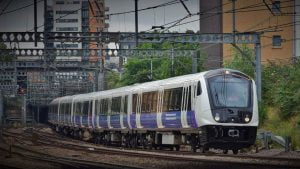The Rail Accident Investigation Branch has released a report into a signal passed at danger at a Staffordshire junction.
On the 22nd August 2023, a Freightliner Class 90 locomotive passed a red signal on the approach to Stafford Trent Valley Junction No. 1 at around 16:41.
The Class 90 was on a test run after repair work and continued for 740 metres beyond the signal, before running through points and coming to a stand at the junction.
Where the locomotive stopped, it conflicted a route that was set for a southbound train – whilst a train was not in the immediate vicinity at the time, a northbound train passed the junction just a few seconds before the locomotive reached the points – though the locomotive did not foul the line that the northbound train was travelling on.
No one was injured in the incident and the locomotive did not derail, though some damage was caused to the points which were run through.
The RAIB’s investigation found that the locomotive was travelling too fast as it approached the red signal, meaning it could not stop before passing it.
The investigation also found that the driver was distracted on approach to previous signals before the red signal due to them dealing with a fault on the locomotive.
The fault caused the locomotive to come to a stop at a previous signal and it is possible that the previous signal was not clearly visible to the driver when they restarted the train.
Additionally, the RAIB says that the presence of the fault, and the need to rectify it distracted the driver who had not experienced this sort of scenario before.
Findings by the RAIB say that Freightliner had no formal process for managing the risks of operating locomotives on test runs and light engine movements, and the operator’s competence management system had not equipped the driver to deal with an expected issue and the potentially distracting nature of this.
The RAIB also found that the incident was exacerbated due to the high level of acceleration applied after the driver had cleared the fault. They also found that no safety system had intervened to apply the locomotives brakes before the driver applied them.
As a result of its investigation, the RAIB has made two recommendations to Freightliner:
- The first deals with reviewing risk assessments and processes for the operation of light locomotives and test runs, to better manage the operational risk.
- The second relates to how train drivers are trained and assessed in the skills required to manage out-of-course, abnormal and potentially stressful events.
Finally, the RAIB has identified three learning points from the incident
These relate to the need to comply with rules relating to locomotive speeds, the requirements for the development and maintenance of route knowledge, and settings for train protection systems.






Responses
I say kick the private and the privilege sectors out of the railways and bring them back under public ownership tell the government were to go and stop fleecing the British people who want a safer railway and cheap tickets not pay expensive ones were you get a poor service meed to consider changing as this is not working before we don’t have a railway
Back when it was BR when I took locos out on test runs from crewe works to church stretton I had the fitters on board with me I did the driving and they monitored the loco.
This will always happen need people to learn to drive locomotives like in the 80s and 90s were you have two crew not one on there own that way if they run a red there is always a second man there to take control of the unit private sectors took that away just like governments do now just to save money I say bring back second crew members the railways will be a lot safer as the units are equipped with new technology 😉
BR had 800 to 900 spads per year back in the 80s. Now average 250 per year.
There is no excuse at all for passing a signal at Danger. Its just bad driving and it’s up to the driver to drive and respond to the situation he is driving in.
guessing you didn’t read it at all, its Freightliner’s fault for not fully training the driver for that sort of situation
What a Railway we now have.im ex BR and never use them now.gone to the dogs..
Human error, lack of proper training and experience. Nothing new. Most accidents are the result of several factors that arrive simultaneously.
Is it possible if train aproaching not totaly in contril a fail safe comes into play
If the onboard safety systems didn’t kick in and stop the train then I think that it wasn’t repaired properly!!
This story takes me back 10 years when an over speeding DCR loco ended up in a very similar situation at the same location. It is sad and worrying when lessons aren’t learnt